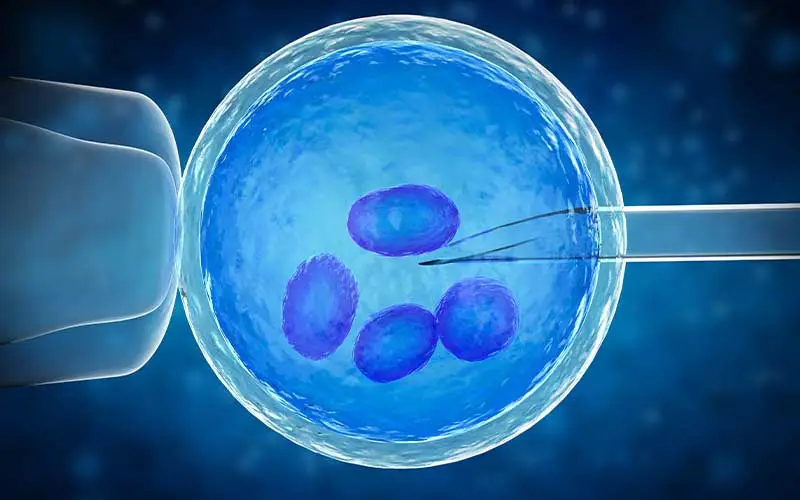Free Consultation Form
IVF treatment; In vitro fertilization, infertility; is a reproductive medical treatment method used to increase the chances of pregnancy of couples or individuals experiencing infertility problems. IVF is a procedure developed to help people who are unable to get pregnant naturally or have other reproductive problems.
IVF treatment is one of the most preferred infertility treatments today. In cases where the cause is unexplained infertility, infection, blockage in the tubes, a man’s sperm quality is low, weight or advanced age, couples can have babies with IVF method.

IVF treatment involves the treatment process that allows fertilization of eggs, which are female reproductive cells, and sperm, which are male reproductive cells, to be collected outside the body and brought together in a laboratory environment.
In IVF treatment, fertilized eggs start to divide and spend the first stages of development called embryos in the laboratory environment, while the mother is placed in the uterus of the candidate. The pregnancy obtained after this stage is no different from the pregnancies that occur naturally.
The difference of IVF treatment from natural pregnancy is that the fertilization process is carried out under laboratory conditions and the fertilized eggs are placed back into the mother’s uterus. Especially in male infertility, “vaccination treatment” can be preferred before IVF treatment. The sperm collected in this method is transferred into the uterus.
Brief Stages of IVF Treatment
- Before starting IVF treatment, couples or individuals meet with a reproductive doctor. In these interviews, the causes of infertility are evaluated and a treatment plan is formed. Pre-treatment tests are performed and treatment options such as hormonal medications are determined.
- The first stage of IVF treatment is the stimulation of the woman’s ovaries to produce more than one egg. This is done using hormonal drugs or injections. Ultrasound and blood tests are often done to monitor egg development.
- When the eggs reach the appropriate size in IVF treatment, follicle aspiration or egg collection, which is a surgical procedure, is performed. In this process, with the help of a needle, the eggs are removed from the follicles.
- In IVF treatment, a sperm sample is taken from the man and prepared in the laboratory. In some cases, a sperm donor may be used because of sperm problems.
- In IVF treatment, the eggs collected and the prepared sperm are brought together in the laboratory. At this stage, fertilization takes place and embryos are formed.
- Among the embryos formed for IVF treatment, the healthiest and strongest ones are selected. The selected embryos are prepared to be placed in the uterus.
- In IVF treatment, the selected embryos are placed in the woman’s uterus with the help of a thin catheter or tube. This procedure is painless and usually does not require local anesthesia.
- In IVF treatment, a few weeks are expected after the transfer and then a pregnancy test is done. When a positive result is obtained, the pregnancy progresses and pregnancy is followed.
IVF treatment depends on many factors to achieve a successful pregnancy and can give different results for each couple or individual. Before starting treatment, a detailed evaluation of your medical history and specific condition should be done with a reproductive doctor.
How Is IVF Treatment Done?
Women who menstruate regularly form a single egg each month. In IVF treatment, it is aimed to increase this number with hormone drugs given externally. Although each treatment protocol varies, there are basically two parallel hormone treatments that enable egg development and prevent premature ovulation.

During the use of these hormone drugs, ultrasound and blood tests are performed to monitor the response of the ovaries, that is, the development of the egg, and to make dose adjustments when necessary.
In this way, the eggs that reach maturity are collected by a simple needle aspiration method known as a cracking needle and they are fertilized with sperm taken from the man in the laboratory environment. The collection of eggs can be done under general anesthesia, as well as under sedation and local anesthesia.
This fertilization process can be achieved by leaving sperm and eggs side by side in the classical IVF method, as well as by injecting each sperm called micro-injection into a single egg under a high magnification microscope. Your doctor will tell you which method is best for you.
Fertilized eggs are allowed to develop in the laboratory for 2 to 3 days or in some cases for 5 to 6 days in a temperature and atmosphere controlled culture environment, and the best developing embryos are selected and placed back into the uterus.
Since the determination of the number of embryos to be transferred will have a direct effect on the chance of pregnancy and the risk of multiple pregnancies, this number will be discussed with you in detail before the transfer. The embryo transfer process does not require anesthesia and sedation except in very rare cases.
What Is The Difference Of Vaccination Treatment From IVF?
Especially in cases of male-related and unexplained infertility, vaccination treatment is at the beginning of the preferred treatments before IVF treatment. In vaccination, the ovaries of the woman are stimulated, as in IVF treatment, after the eggs are cracked, the sperm taken from the man is transferred into the uterus with a cannula.
At least one of the woman’s tubes must be open for vaccination to be administered. The results of the sperm analysis of the man should be normal or close to normal. Also, there should be no endometrial pathology in the woman that will prevent the pregnancy from holding on.
How Old Can The Patient Be For IVF Treatment To Be Done?
In IVF treatment, the woman’s ovarian reserves are evaluated first. Quantity 3. hormone tests and ultrasonography performed on the day of the ovarian reserve is examined. If the ovarian reserve is found to be good in this examination, IVF treatment can be done up to the age of 45.
However, due to the negative effects of age progression, the embryo needs to be examined in terms of chromosomes. In addition, women who will start IVF treatment after the age of 38 should resort to the preimplantation genetic diagnosis method and evaluate the status of their embryos.
After the age of 35, the number of eggs decreases, ovulation is disrupted, and the quality of the egg deteriorates. Even if the ovarian reserves are suitable for the IVF, the chances of success in the IVF also decrease. For these reasons, it is important for women who have infertility problems to start treatment without waiting for old age in order to have children.
For a woman who is older and has problems in the ovary chamber, there is no method for the realization of pregnancy in IVF treatment. pregnancies over the age of 35 are classified as high-risk pregnancies and should be monitored by perinatologists.

What Is The Age Limit For Men In IVF Treatment?
Sperm production continues at any age. However, with age, the quality of sperm decreases. in men over 55 years of age, sperm motility can be reduced by 54 percent. It is believed that sperm DNA is degraded as age.
Is There A Risk Of Multiple Pregnancies In IVF Treatment?
The chance of having a twin pregnancy when a single embryo is given; one-egg twins are very few. when 2 embryos are given, the twin pregnancy; double-egg twins are about a third of the time. Very rarely 2 embryos are given, but 3 or even 4 babies can be born; one of the given embryos, sometimes both, can divide into identical twins.
Couples who receive assisted reproductive treatment such as IVF and vaccination and who cannot have children for a long time may want multiple pregnancies. Since multiple pregnancies are considered risky, the doctor and the patient must decide together the number of embryos to be transferred. Non-transferable embryos can be frozen for 5 years.
Today, the rate of multiple pregnancies with assisted reproductive techniques is between 20 and 30%. Most of the plural pregnancies are rarely triplets and more.
What Is The Success Rate Of IVF Treatment?
The inability to conceive from sperm or ovaries also affects couples psychologically. Which method to use in IVF treatment applied in order to make the dreams of couples to have children a reality is decided in accordance with the health status of the patients and the evaluations of the experts. The goal of treatment is always to ensure that fertilization takes place and that the pregnancy period is healthy.